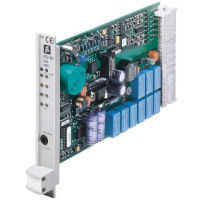Switch isolators supply power to the proximity sensor in a hazardous area, receive a proportional current, convert input signals to digital output signals and transfer switching signals to a control device such as DCS or PLC.
The switch isolator consists of three primary components: the power supply, the transistor switch amplifier and the output stage. Galvanic isolation separates the input, output and power supply circuits.
The isolator input stage is designed in accordance with DIN EN60947 (NAMUR). This means the residual voltage in normal operation is approximately 8 VDC and the short circuit current is approximately 8 mA. The switch points are typically between 1.2-2.1 mA.
Many Pepperl+Fuchs isolators offer optional lead breakage and short circuit monitoring (activated by slide switches) for the hazardous area circuit. These isolators feature three outputs that can be reversed using the mode of operation switch: relay, active transistor and passive transistor outputs.






 +49 621 776-0
+49 621 776-0